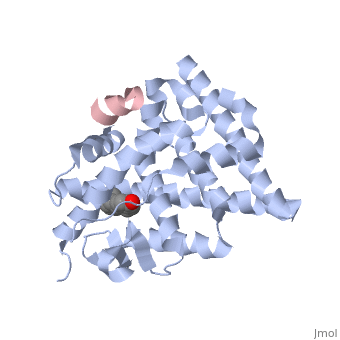1gwr: Difference between revisions
No edit summary |
No edit summary |
||
| Line 7: | Line 7: | ||
|ACTIVITY= | |ACTIVITY= | ||
|GENE= | |GENE= | ||
|DOMAIN= | |||
|RELATEDENTRY= | |||
|RESOURCES=<span class='plainlinks'>[http://oca.weizmann.ac.il/oca-docs/fgij/fg.htm?mol=1gwr FirstGlance], [http://oca.weizmann.ac.il/oca-bin/ocaids?id=1gwr OCA], [http://www.ebi.ac.uk/pdbsum/1gwr PDBsum], [http://www.rcsb.org/pdb/explore.do?structureId=1gwr RCSB]</span> | |||
}} | }} | ||
| Line 14: | Line 17: | ||
==Overview== | ==Overview== | ||
The activation function 2/ligand-dependent interaction between nuclear receptors and their coregulators is mediated by a short consensus motif, the so-called nuclear receptor (NR) box. Nuclear receptors exhibit distinct preferences for such motifs depending both on the bound ligand and on the NR box sequence. To better understand the structural basis of motif recognition, we characterized the interaction between estrogen receptor alpha and the NR box regions of the p160 coactivator TIF2. We have determined the crystal structures of complexes between the ligand-binding domain of estrogen receptor alpha and 12-mer peptides from the Box B2 and Box B3 regions of TIF2. Surprisingly, the Box B3 module displays an unexpected binding mode that is distinct from the canonical LXXLL interaction observed in other ligand-binding domain/NR box crystal structures. The peptide is shifted along the coactivator binding site in such a way that the interaction motif becomes LXXYL rather than the classical LXXLL. However, analysis of the binding properties of wild type NR box peptides, as well as mutant peptides designed to probe the Box B3 orientation, suggests that the Box B3 peptide primarily adopts the "classical" LXXLL orientation in solution. These results highlight the potential difficulties in interpretation of protein-protein interactions based on co-crystal structures using short peptide motifs. | The activation function 2/ligand-dependent interaction between nuclear receptors and their coregulators is mediated by a short consensus motif, the so-called nuclear receptor (NR) box. Nuclear receptors exhibit distinct preferences for such motifs depending both on the bound ligand and on the NR box sequence. To better understand the structural basis of motif recognition, we characterized the interaction between estrogen receptor alpha and the NR box regions of the p160 coactivator TIF2. We have determined the crystal structures of complexes between the ligand-binding domain of estrogen receptor alpha and 12-mer peptides from the Box B2 and Box B3 regions of TIF2. Surprisingly, the Box B3 module displays an unexpected binding mode that is distinct from the canonical LXXLL interaction observed in other ligand-binding domain/NR box crystal structures. The peptide is shifted along the coactivator binding site in such a way that the interaction motif becomes LXXYL rather than the classical LXXLL. However, analysis of the binding properties of wild type NR box peptides, as well as mutant peptides designed to probe the Box B3 orientation, suggests that the Box B3 peptide primarily adopts the "classical" LXXLL orientation in solution. These results highlight the potential difficulties in interpretation of protein-protein interactions based on co-crystal structures using short peptide motifs. | ||
==About this Structure== | ==About this Structure== | ||
| Line 27: | Line 27: | ||
[[Category: Brzozowski, A M.]] | [[Category: Brzozowski, A M.]] | ||
[[Category: Pike, A C.W.]] | [[Category: Pike, A C.W.]] | ||
[[Category: activator]] | [[Category: activator]] | ||
[[Category: af2 coactivator]] | [[Category: af2 coactivator]] | ||
| Line 44: | Line 43: | ||
[[Category: zinc finger]] | [[Category: zinc finger]] | ||
''Page seeded by [http://oca.weizmann.ac.il/oca OCA ] on | ''Page seeded by [http://oca.weizmann.ac.il/oca OCA ] on Sun Mar 30 20:52:54 2008'' | ||
Revision as of 20:52, 30 March 2008
| |||||||
| , resolution 2.4Å | |||||||
|---|---|---|---|---|---|---|---|
| Sites: | |||||||
| Ligands: | |||||||
| Resources: | FirstGlance, OCA, PDBsum, RCSB | ||||||
| Coordinates: | save as pdb, mmCIF, xml | ||||||
HUMAN OESTROGEN RECEPTOR ALPHA LIGAND-BINDING DOMAIN IN COMPLEX WITH 17BETA-OESTRADIOL AND TIF2 NRBOX3 PEPTIDE
OverviewOverview
The activation function 2/ligand-dependent interaction between nuclear receptors and their coregulators is mediated by a short consensus motif, the so-called nuclear receptor (NR) box. Nuclear receptors exhibit distinct preferences for such motifs depending both on the bound ligand and on the NR box sequence. To better understand the structural basis of motif recognition, we characterized the interaction between estrogen receptor alpha and the NR box regions of the p160 coactivator TIF2. We have determined the crystal structures of complexes between the ligand-binding domain of estrogen receptor alpha and 12-mer peptides from the Box B2 and Box B3 regions of TIF2. Surprisingly, the Box B3 module displays an unexpected binding mode that is distinct from the canonical LXXLL interaction observed in other ligand-binding domain/NR box crystal structures. The peptide is shifted along the coactivator binding site in such a way that the interaction motif becomes LXXYL rather than the classical LXXLL. However, analysis of the binding properties of wild type NR box peptides, as well as mutant peptides designed to probe the Box B3 orientation, suggests that the Box B3 peptide primarily adopts the "classical" LXXLL orientation in solution. These results highlight the potential difficulties in interpretation of protein-protein interactions based on co-crystal structures using short peptide motifs.
About this StructureAbout this Structure
1GWR is a Protein complex structure of sequences from Homo sapiens. Full crystallographic information is available from OCA.
ReferenceReference
Interaction of transcriptional intermediary factor 2 nuclear receptor box peptides with the coactivator binding site of estrogen receptor alpha., Warnmark A, Treuter E, Gustafsson JA, Hubbard RE, Brzozowski AM, Pike AC, J Biol Chem. 2002 Jun 14;277(24):21862-8. Epub 2002 Apr 5. PMID:11937504
Page seeded by OCA on Sun Mar 30 20:52:54 2008
